

February 10, 2021
By Jeanne Allen, Founder and CEO of CER
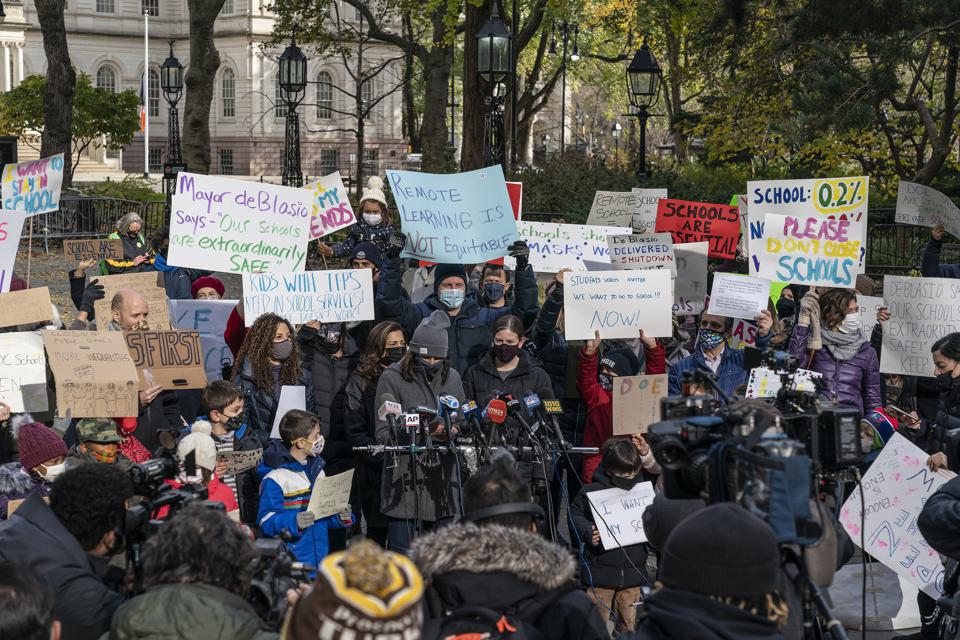
NEW YORK, UNITED STATES – 2020/11/19: Frustrated parents and their children rally against Mayor’s decision to close public schools and demanded to re-open them immediately at City Hall. Public schools were closed on Thursday November 19 citywide because rolling 7-day coronavirus positivity rate crossed the 3% threshold. However private and parochial schools remain open. More than 10,000 parents signed this petition. (Photo by Lev Radin/Pacific Press/LightRocket via Getty Images)
Every morning he gets up, takes the dogs out, gets dressed and embarks for school, in person. The private school music department head teaches 300+ students every day. So far, since September, there have been fewer than 10 reported cases among students in the whole school of just over 600. He’s not sick, nor has he been.
My husband is one of thousands of educators following their same patterns who since prior to March have continued to provide education and care to millions of students around the country.
In September, the Charter Growth Fund reported that IDEA Public Schools “offered in-person learning five days a week in two regions after extensive engagement with staff and families in those regions.” Across the Permian Basin, nearly 75% of families wanted in-person learning. Now, all IDEA schools across Texas and Louisiana are offering an in-person learning option.
Purdue Polytechnic in Indianapolis opened in person and “had about 10 staff and 25 students quarantine with symptoms, but no confirmed cases. ‘We have said that we will have positive cases at some point in time, and we will follow the plan and not panic and close down,’ said its Director Scott Bess.” Its “Safe Reopening Plan” allows week to week evaluations of what’s best for students. But never did they dream of staying home until all risk was out of the way.
Miami-Dade is the fourth largest school district in the country and fully reopened. “Here in Miami-Dade, we see a greater adherence to protocols in schools — because it is a controlled, safe environment — than we see those same protocols being followed in their community in general, whether we’re talking about the bars and restaurants at the beach or social gatherings,” said Miami-Dade schools superintendent Alberto Carvalho.
The Carlstadt-East Rutherford Regional School District in New Jersey has been open fully since October, starting with a “hybrid schedule in early September, and running fully in-person five days a week since Oct. 19. The district “is still ticking,” even with a few positive cases reported on a monthly basis, according to Superintendent Dario Sforza.” “Schools are safe places and we’ve proven that,” Sforza told New Jersey 101.5. “With each case, we don’t act compulsively.” In St. Louis, where the 7-day average for new COVID cases hovers above 1,500 a day, opened charter schools are drawing students from closed inner city public schools that have long been failing. Hyde Park’s Clay Elementary School will shut down this summer after dropping below 100 student enrollment. One-half mile away, just 89 students attend The Arch Community charter school. At least two new charter schools plan to open in fall of 2022 to serve the same 63107 ZIP code, with a third planning to launch there two years later.
Following months of most schools remaining open through a severe second wave of coronavirus outbreaks in Europe, the data is largely suggesting that classrooms have typically not been the culprit as centers of virus transmission.
So why must parents fight for schools to reopen when there is ample evidence, both anecdotal and scientific, that it’s safe?
The majority of private schools, both abroad and in the States, have been open for in-person learning, along with hundreds of charter schools across the country, independent of district administration to manage or support them in any way. Yet, these schools are continuing to educate kids successfully, and keeping the student body—and the faculty— safe.
But most public systems remain closed. Why? What separates them from the privates, the charters, the innovative schools and organizations who are bucking the odds? Well for starters, individual private schools and charters are making decisions locally, independently, without the bureaucracy or interests of unions and education groups to interfere.
Second, they are making decisions based on their actual students, who often but not always live within miles of the school, rather than making decisions based on whole districts that take up hundreds of acres and sprawl across entire cities.
Those districts are responsible for driving student academic, social and mental health into a potential unwinnable spiral – not because they caused Covid, but because they refuse to deal with the virus, preferring a guarantee of no infection to showing up o
n the job. That’s the headline of a recent Associated Press story, which confirmed the worse – that even now, after the billions in federal and state money have flowed and increased to schools to create safety precautions, districts are warning they still not be open this fall, and some are saying not until the virus is “eradicated!”
The fact that teachers all over the country are showing up to work safely doesn’t seem to enter into any decision making. “My children have been in school all year here in Omaha,” wrote one parent. “If a single teacher died or even had a severely negative covid hospitalization due to in-person teaching it would not only be a local news story but would be national headlines. There have been none. That is a fact.”
Imagine the nurse or doctor or essential grocery worker who simply chooses not to go to work, despite safety precautions that their employers have taken, for fear that they will still get sick. Some do, most don’t. Those that do get fired. And that’s precisely how we should expect schools to operate.
First, each school should be opened to its zoned community, with already approved, and executed precautions and safety procedures in place, with parents and teachers, not unions and superintendents deciding whether it’s safe, on an individual basis, not closing the entire school district. If teachers are unable or unwilling to be on site, the school itself – not the district- should have the flexibility to hire other personnel or buy instructional services from the myriad of digital learning providers who have filled the gap during the pandemic, from Edmentum, to StrideLearning to microschool provider Prenda.
Second, any parent still deeply concerned about their children’s educational and physical health or without access to viable in-person schooling should be given $3,000 from the state’s budget to spend on the education they prefer in any venue of their choosing. Doing so not only pays for a full-time microschool, or curriculum, or nearly half of any private school, but it’s likely that many community institutions would find ways to give those students access to buildings with guides, tutors or instructors.
States that claim not to have the resources should make immediate plans to utilize the $130 billion that is coming next from Washington. The current proposal would allow districts to “set aside at least 20 percent of their allocation of funding to address learning loss during the pandemic.” If the federal government, and its special interest concerns move to forbid it, states should do it anyway and challenge consequences in court.
During this time of unparalleled international crisis, education must be treated as an issue of national security. We must no longer permit students to continue to lose ground in learning, especially when the tools, resources and practices to fight the battle for successful education are already in proven deployment throughout the nation.
Berman: “The question is ‘is it safe for teachers to go back to school?’ It’s a very specific question. I don’t understand why it’s a hard question to answer.”
Sanders: “It is the Administration’s position that teachers should be prioritized for vaccinations. …”
Berman: “Does the president feel that teachers have to be vaccinated for schools to open, yes or no?”
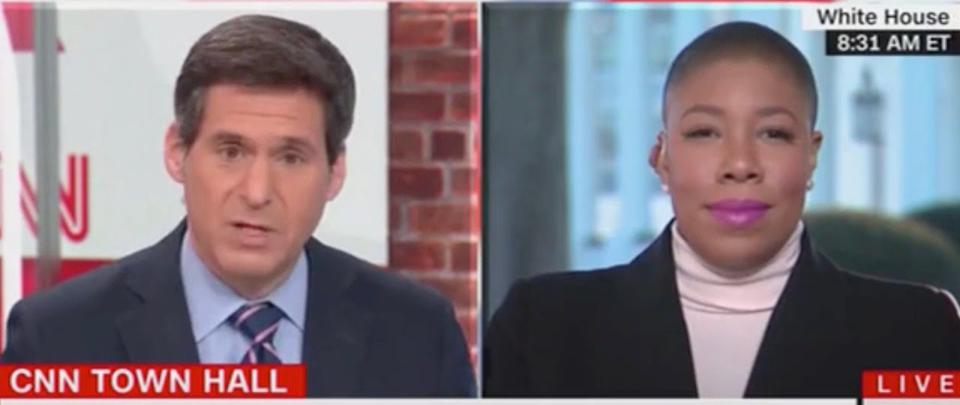
Symone Sanders, the chief spokesperson for Vice President Kamala Harris, repeatedly dodged a question Wednesday from CNN host John Berman on whether or not need the coronavirus vaccine in order for schools to safely reopen. CNN / YOUTUBE And once again Sanders dodges him, and Berman gets no answer.
The Administration is bending to the unions, which despite colorful pictorial articles written about their willingness to find common ground, are refusing to negotiate.
Just yesterday, Philadelphia Federation of Teachers president Jerry T. Jordan, who has long complained about not enough resources or assurances of safety to open, announced that the schools still would not open. Claiming it is the decision of the district (as if they don’t control when teachers show up and not), Jordan wrote, “the Federation’s position that we are unable to verify the safety of buildings for reoccupancy… remains unchanged.”
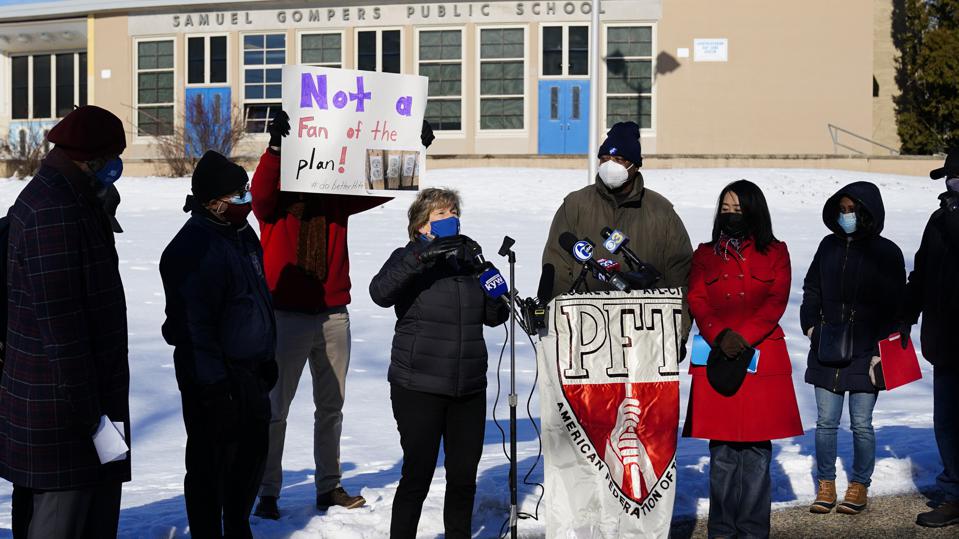
American Federation of Teachers President Randi Weingarten, center left, speaks during a news conference outside Samuel Gompers Public School in Philadelphia, Monday, Feb. 8, 2021. A mediator will decide if Philadelphia school teachers must return to their classrooms despite safety concerns as the district plans to resume in-person instruction later this month. (AP Photo/Matt Rourke) AFT president Randi Weingarten, who once infamously compared school choice options for kids to segregation, tweeted her approval of this decision, after pledging that she is working tirelessly on the issue of getting teachers and students back in school. Weingarten is confident schools will reopen, saying, “Take me at my word.” (Yet it’s common knowledge to union experts that Philly’s Jordan doesn’t make a move without her approval). And is the union’s involvement helping students? Years of research suggests otherwise: “Unions do not appear to help — and might actually hinder — student test scores and graduation rates. Early research suggests that students in unionized districts earn slightly higher achievement scores. But …the most rigorous studies, which were conducted in more recent years, indicate that students in unionized districts have slightly higher dropout rates and slightly lower rates of math and reading proficiency.”
Which begs the question as to why the politicians abide union behavior.
Chicago Mayor Lori Lightfoot says the unions are “something akin to a political party…” and that “LA and San Francisco had to sue to force the conversation about reopening.”Meanwhile, the union she has supported for years accused her of racism (Lightfoot is Black) and said that school closures would not poorly affect student outcomes. The statement is irresponsible – and harmful.
Millions of parents are struggling just to keep up with learning, knowing that:
- Fewer than twenty percent of lower income fourth grade students alone are proficient in math and reading in a “normal” year, in a traditional public school. The average proficiency is only 40 percent.
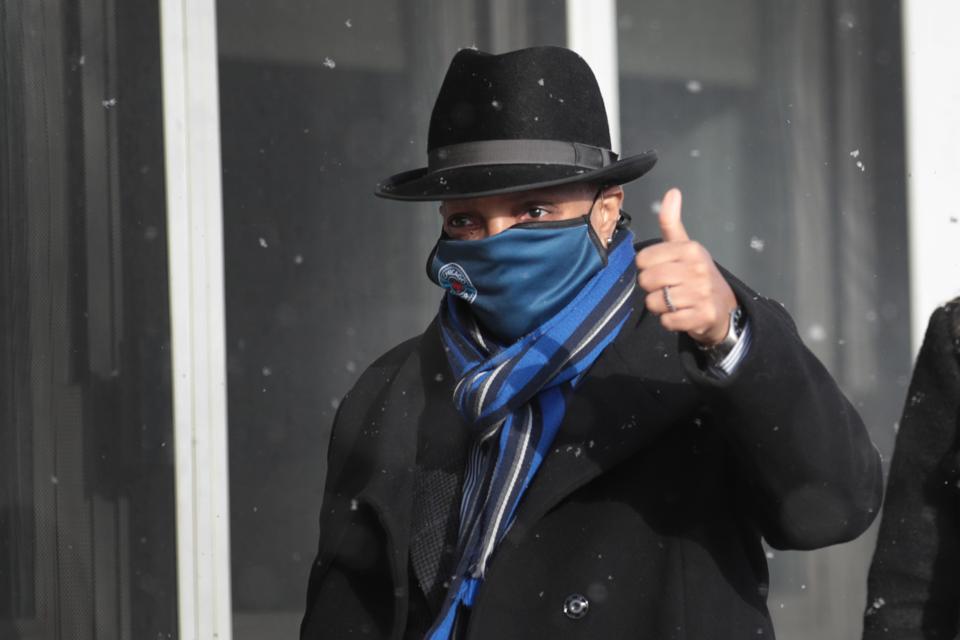
CHICAGO, ILLINOIS – FEBRUARY 11: Chicago Mayor Lori Lightfoot visits William H. Brown School of Technology as student begin returning to in-person instruction on February 11, 2021 in Chicago, Illinois. The city recently reached an agreement with the teachers union to phase in in-person instruction beginning today with pre-kindergarten and special education students returning today. (Photo by Scott Olson/Getty Images)
- That one in six students who do not read proficiently by third grade are four times more likely to not graduate high school (approximately 22%).
- Math proficiency is linked to college readiness.
- The median wage for high school dropouts is one and half times lower than high school graduates.
Which begs the question as to why the politicians abide union behavior.
Chicago Mayor Lori Lightfoot says the unions are “something akin to a political party…” and that “LA and San Francisco had to sue to force the conversation about reopening.”
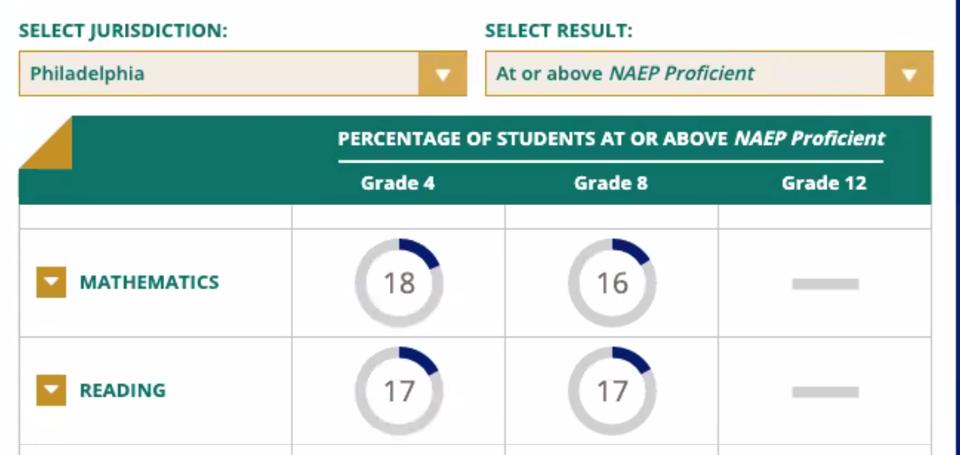
Detail of data from the Nation’s Report Card showing Math and Reading performance in Philadelphia schools. NAEP / NATION’S REPORT CARDYet, the unions are ignoring the educational purpose of schooling, and instead are demanding more resources to open, ignoring the science and acting as if they have no control over the situation.
Of the $68 billion allocated for school reopenings and safety through states, districts have drawn down only $4 billion of it, and the unions are demanding more, claiming they need more resources to open. It’s likely that this maneuvering is a big fat bargaining chip, and that when the nation’s kids are at their absolute worst, they will use this to secure a major federally subsidized pay raise that will magically result in them unlocking the gates.
It will be too late by then, and their miscalculations now and in the future will be met by not only fury, but a major rejection of their policies. Despite polls saying otherwise (and most who answer polls about education are unlikely to be parents on the front lines answering unknown callers or online surveys), unions will reap what they sow. And the children will suffer.Follow Jeanne on Twitter or LinkedIn or some of her other work here.
Founded in 1993, the Center for Education Reform aims to expand educational opportunities that lead to improved economic outcomes for all Americans — particularly our youth — ensuring that conditions are ripe for innovation, freedom and flexibility throughout U.S. education.

